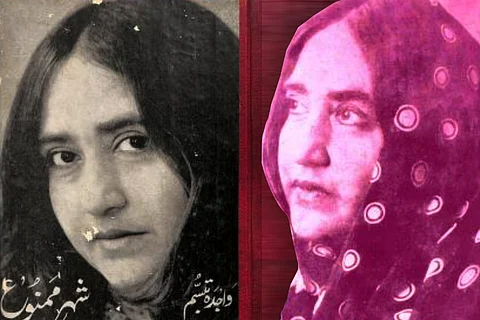

Ek boseeda haveli yaani fursooda samaj, Le rahi hai naza ke aalam mein murdon se khiraj (The ghosts of outdated societal norms still wander in a dilapidated mansion, yet they continue to be paid obeisance even as they undergo deterioration). The once palatial mansions, which leftist Telangana poet Makhdoom Mohiuddin alluded to in these verses, are not just symbols of Hyderabad’s once exalted aristocracy. They were also the settings of some semi-erotic Urdu short stories by the Amravati (once nominally a part of the Nizam’s state), Maharashtra-born Wajida Tabassum. Although not as feted or translated prolifically as Sadat Hasan Manto and Ismat Chughtai, her stories are as infamous as they are intrepid. I only found her work in Hyderabad’s hub of rare books after coming up short in my search for them at the city’s more prominent Urdu bookstores. Within these stories are characters — mostly women — who suffer within the rigid social structures of Princely regimes.
Some Deccani folk laud Tabassum’s prose for showcasing the dark side of the aristocracy whose debauched, exploitative ways knew no end. On the other hand, certain ordinary and literary Hyderabadis believe that she built a career upon perpetuating every possible stereotype of Nawabi debauchery. Common salvos in defence of Hyderabad’s culture from her writing include: “Which society doesn’t have such evils?” and “Based off her own unsavoury experiences with the nobility, her stories painted our land and its people with the same brush through obscene, trashy writing.”
In an earnest attempt to reintroduce this forgotten iconoclastic voice, Pakistani journalist and author Reema Abbasi translated some of her stories and compiled them into a brief collection titled Sin. Whether one reads these stories in English or Urdu, it is clear that they titillated readers during a time where easily accessible racy content via the internet was non-existent.
In Ladki Bazar (translated as Flesh Market), every year Nawab Habib Yar Jung’s sycophantic servant organises his master’s nuptials with multiple girls whose poor mothers offer their daughters to him in exchange for money. For this annual ritual to take place, he readily divorces the girls he married during the previous year. While discarding them, he offers to pay a monthly stipend to one of his pregnant ex-wives. Be it sweetening an abandonment with the young mother of his unborn child by promising her regular money, or having the lover of a potential entrant into his harem incarcerated, feudal tyranny doesn’t ensure happy endings for Ladki Bazar’s protagonists.
Throughout Sin, this cruelty mostly reigns supreme over Hyderabad’s most vulnerable subjects.
In spite of this, some stories have the high and mighty Nawabs getting checkmated by their victims. How would this be possible in an environment where hierarchies and socially regressive traditions are causes and effects of a jagirdar’s conceit? Because bringing about a revolution is simply out of the question for the original author’s protagonists. Yet, some of them do earn moral victories by denting the quality that upholds these exploitative setups — pride.
For instance, in Zakaat (The Alms of Death), Nawab Zain Yar Jung seeks to keep reinvigorating his youth with an endless supply of young, beautiful girls.
Oddly enough, Zain sees these unions to young girls as a part of the signature munificence that he lavishes upon landed and non-landed folk. He takes immense pride in being seen as a benefactor of charity. That too, one who doesn’t accept the most well-meaning gift. This changes when a helpless family, whose daughter is named Ujala, catches the Nawab’s eye. They refuse to sell her outright but instead agree to a temporary Mut’ah marriage as per Shiite Sharia Law. At a gathering of the Nawab’s closest friends and sycophants, Ujala announces that she was the first one to shower upon him the alms of her beauty without any monetary compensation.
She proclaims, “He, Nawab Zain Yar Jung, was the first in my long line of beggars. Today, I ask him, the man who turned down every present, how he accepted charity from a poor girl.”
This mere declaration literally ends up killing the magnanimous aristocrat.
Almost every villainous noble dons the traditional Salim Shahi shoes, ornate shervani, and Rumi Topi. These sartorial traditions are still in vogue among Hyderabadis today. Hence, many from Hyderabad city always believed that such stories caricatured them.
Abbasi’s reincarnation is adept at channelling Wajida’s subversive, scandalous spirit. Whether it is the originals or Sin, both leave no stone unturned in seemingly ridiculing the landed gentry.
Though like most translations of Urdu literature, it lacks the linguistic flavour indigenous to the source material’s setting. Beyond the colloquial hao and nakko, the Deccani language not only oozes piquancy, but is a fountain of a rich tradition of humour and satire.
Rozi Ka Sawaal starts off with one prostitute using the crassest Urdu as well as Telugu expletive to lambast a co-worker. The English version, The Cost of Survival, also commences with Wajida’s signature salaciousness too but without that obscene word. The absence of the Deccani invectives and parlance deprive the translation of the original’s carnal tone and milieu.
According to the self-authored preface (translated as My Story in Sin) of one of her collections, Shehr-e-Mamnu, Wajida arrived in Hyderabad during the 1947 partition right before the Nizam-ruled state acceded to India. She claimed that she called a spade a spade with regard to what went on in an aristocratic mansion. Were hyperbolic liberties taken by her to denigrate a land and its people?
The answer to that is simply a matter of perspective.
Other wordsmiths have also chronicled the demise of Hyderabad’s landed gentry. One such author is Najma Nikhat whose works aren’t as controversial and are devoid of local parlance. Hopefully, Reema Abbasi’s latest offering will provide impetus for those proficient in English and Urdu to (re)introduce other authors from the Deccan.
Daneesh Majid is a Hyderabad-based writer and researcher on South Asian culture and security.